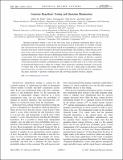| dc.contributor.author | Wilde, Mark M. | |
| dc.contributor.author | Tomamichel, Marco | |
| dc.contributor.author | Lloyd, Seth | |
| dc.contributor.author | Berta, Mario | |
| dc.date.accessioned | 2018-04-05T14:01:06Z | |
| dc.date.available | 2018-04-05T14:01:06Z | |
| dc.date.issued | 2017-09 | |
| dc.date.submitted | 2016-09 | |
| dc.identifier.issn | 0031-9007 | |
| dc.identifier.issn | 1079-7114 | |
| dc.identifier.uri | http://hdl.handle.net/1721.1/114559 | |
| dc.description.abstract | Quantum hypothesis testing is one of the most basic tasks in quantum information theory and has fundamental links with quantum communication and estimation theory. In this paper, we establish a formula that characterizes the decay rate of the minimal type-II error probability in a quantum hypothesis test of two Gaussian states given a fixed constraint on the type-I error probability. This formula is a direct function of the mean vectors and covariance matrices of the quantum Gaussian states in question. We give an application to quantum illumination, which is the task of determining whether there is a low-reflectivity object embedded in a target region with a bright thermal-noise bath. For the asymmetric-error setting, we find that a quantum illumination transmitter can achieve an error probability exponent stronger than a coherent-state transmitter of the same mean photon number, and furthermore, that it requires far fewer trials to do so. This occurs when the background thermal noise is either low or bright, which means that a quantum advantage is even easier to witness than in the symmetric-error setting because it occurs for a larger range of parameters. Going forward from here, we expect our formula to have applications in settings well beyond those considered in this paper, especially to quantum communication tasks involving quantum Gaussian channels. | en_US |
| dc.publisher | American Physical Society | en_US |
| dc.relation.isversionof | http://dx.doi.org/10.1103/PhysRevLett.119.120501 | en_US |
| dc.rights | Article is made available in accordance with the publisher's policy and may be subject to US copyright law. Please refer to the publisher's site for terms of use. | en_US |
| dc.source | American Physical Society | en_US |
| dc.title | Gaussian Hypothesis Testing and Quantum Illumination | en_US |
| dc.type | Article | en_US |
| dc.identifier.citation | Wilde, Mark M. et al. "Gaussian Hypothesis Testing and Quantum Illumination." Physical Review Letters 119, 12 (September 2017): 120501 © 2017 American Physical Society | en_US |
| dc.contributor.department | Massachusetts Institute of Technology. Department of Mechanical Engineering | en_US |
| dc.contributor.department | Massachusetts Institute of Technology. Research Laboratory of Electronics | en_US |
| dc.contributor.mitauthor | Lloyd, Seth | |
| dc.relation.journal | Physical Review Letters | en_US |
| dc.eprint.version | Final published version | en_US |
| dc.type.uri | http://purl.org/eprint/type/JournalArticle | en_US |
| eprint.status | http://purl.org/eprint/status/PeerReviewed | en_US |
| dc.date.updated | 2017-11-14T22:45:41Z | |
| dc.language.rfc3066 | en | |
| dc.rights.holder | American Physical Society | |
| dspace.orderedauthors | Wilde, Mark M.; Tomamichel, Marco; Lloyd, Seth; Berta, Mario | en_US |
| dspace.embargo.terms | N | en_US |
| mit.license | PUBLISHER_POLICY | en_US |
